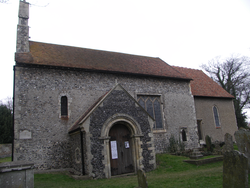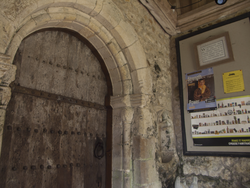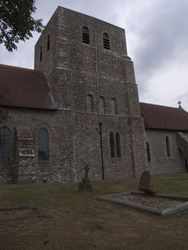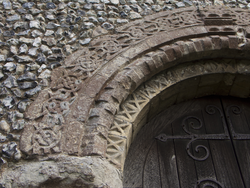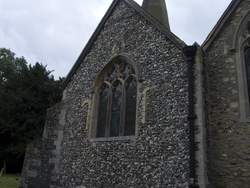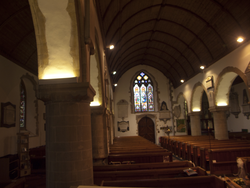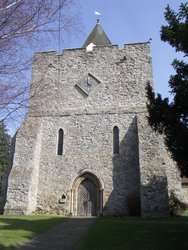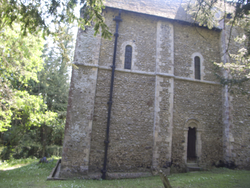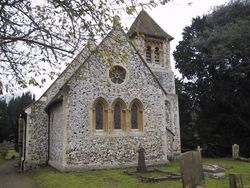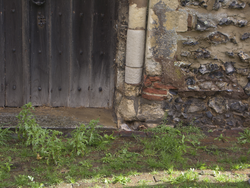
The Corpus of ROMANESQUE SCULPTURE in Britain & Ireland
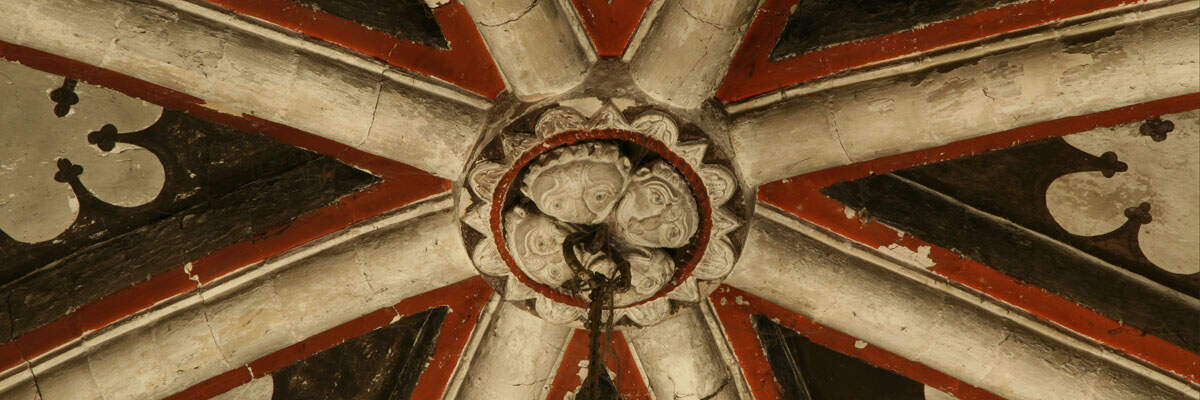
Kent (now)
Parish church
Walmer is a coastal town 6 miles SE of Sandwich and just over 7 miles NE of Dover. The church of St Mary has a twin-cell form with a tall nave and chancel, and a later porch. A N aisle was added in the 17thc and demolished in 1898, returning the building - the 'unsightly object' seen by Glynne in the mid-19thc - back to its original size. A new church dedicated to St Mary was built nearby in the late 19thc, after which the original church became known a 'Old St Mary's' or St Mary the Blessed Virgin. Features of interest include the chancel arch and the S doorway.
Parish church
Mersham is a large village about 3 miles E of Willesborough near Ashford, Kent. The church of St John the Baptist was described by Stephen Glynne in 1877 as 'rather a handsome church, with some singularities, and portions of various styles'. It has nave with S aisle, chancel with S chapel, tower and porch. There is a Romanesque S doorway.
Parish church
Lympne is a village situated about 0.5 mile N of West Hythe, less than 2 miles distant from the Channel coast. The church of St Stephen is a substantial building perched at the edge of a long downwards escarpment looking towards the coast. It comprises a nave, a central tower, a N aisle and a porch. There are two known 19thc restorations. Romanesque work includes the tower arches, tower windows, and font, together with some reset chip carving in the early Gothic N aisle window.
Parish church
Throwley is a small and fairly isolated village near Faversham. The church of St Michael has an aisled nave and a chancel, and a S tower. Romanesque sculpture include the W doorway and some reset fragments in the S tower transept.
Parish church
Bapchild is a village on the old A2 about 1 mile SE of Sittingbourne. The church of St Lawrence has a nave and chancel with N aisle and chapel, a S tower with spire, and a S porch. Romanesque features include the nave arcade and N chapel. Note that the S tower has a blocked round-headed arch and a round-headed window with later tracery, suggesting that the lower level at least is of Romanesque date, but is entirely plain and contains no sculpture.
Parish church
Broadstairs is a coastal town in Thanet, NE Kent, formed from the inland old village of Thanet and small coastal settlements. The church of St Peter in Thanet is a large aisled building with a chancel, porch and a 15thc W tower of flint and ragstone. The N and S nave arcades are Romanesque.
Parish church
Leeds is a village 5 miles E of Maidstone. The church of St Nicholas, mainly built of ragstone with tufa, has an aisled nave, a chancel with chapels, and a low but massive square W tower. The only Romanesque surviving sculpture is in the W tower arch.
Parish church
Brabourne is a village sited 4.5 miles E of Ashford. The church of St Mary the Blessed Virgin has a wide and heavily-buttressed squat W tower, a nave and a chancel with a later S aisle. There are several items of interest, including both the W and the N doorways, the chancel arch and the tower arch.
Chapel, formerly parish church
Betteshanger is a scattered village near Deal. A settlement there is recorded in the Domesday return for Kent, but it is best-known today for the modern colliery which operated for much of the 20th century. The former parish church of St Mary consists of nave, chancel and small bell-tower and was completely rebuilt by Salvin in 1853. It now functions as a school chapel. Visiting only two years before its rebuilding, Glynne noted Norman doorways on both the N and S of the nave in 1851. Today, only the N doorway and its tympanum survives.
Parish church
Borden is a village 2 miles SW of Sittingbourne. The church of St Peter and Paul has aisled nave and chancel, a solid W tower and a S porch. Features of interest include the W doorway and the tower arch.
